It’s human nature to seek out instant gratification, but as search marketers, we are trained to deploy data-driven strategies to hit long-term goals. Unfortunately, our bosses aren’t always content with our long-term strategies.
Fortunately, there is a metric in Google Analytics called page value. Using page value, search marketers can make real-time data-driven insights to positively impact conversions on your site.
What You’ll Learn
- How to use the page value metric to quantify internal linking efforts.
- How goal values impact the page value metric.
- How using an audience-first methodology impacts your ability to target internal linking efforts.
- How to use the page value metric to make data-driven insights to drive conversions from underutilized web pages.
Setting The Scene
Imagine you’re on the search marketing team for an enterprise-level software company. Your boss expects a substantial increase in conversions over the next quarter, and you’re on the hunt for a way to quickly increase goal completions (conversions) on your site.
Continue reading to find out how to connect your audience with the content they’re looking for, and hit your team’s goals for the quarter.
The Fundamentals
Before we dive into the page value use cases, it’s important to understand how page value is calculated. Page value is derived from the goal value metric in Google Analytics, as well as transaction revenue.
Page Value = (Transaction Revenue + Total Goal Value) / Unique Page View
Goal value identifies the dollar value of a given conversion. For example, a conversion might be a demo sign up for your software. Goal values are a dollar amount that you set for a specific on-site action, so it’s important to understand how different conversions are valued within your company.
Setting goal values can be tricky, so check out this article on how to set goal values to make sure you’re on the right track.
Now that we’ve covered goal values, let's dive into page value. First and foremost, it’s important to understand that page value gives a dollar value to a page that contributed to a completed goal in Google Analytics. Meaning, the conversion didn’t actually take place on the target web page, but the user visited the target web page at some point prior to converting.
All in all, page value is “an actionable metric that can help you understand the behavior of your visitors” - (Source: Google Analytics Blog). It’s meant to give you an idea of how an individual page contributes to completed goals in Google Analytics, and gives you insight on the user journey throughout your site.
For more information about page value visit Google Analytics solutions blog.
How Can Search Marketers Use Page Value to Drive More Conversions
When content on your site has high page values and low-medium traffic going to that page, this indicates that the page has a high conversion rate and the potential to drive more quantified traffic. There are a few ways to utilize this metric.
- You can drive more traffic to these pages using a strategic internal linking campaign.
- You can drive more traffic using off-site campaigns (social, PPC, email).
For the purpose of this article, we will focus on internal linking.
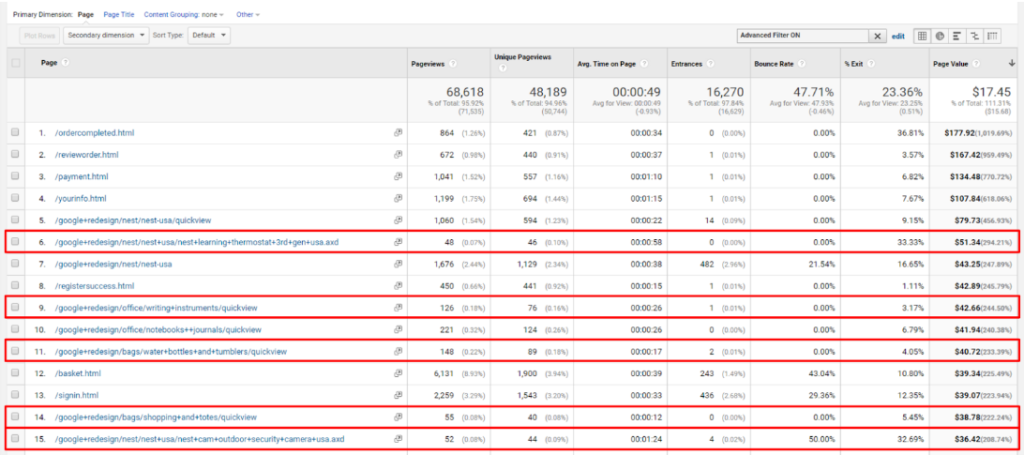
Step 1 - Internal Linking using Page Value
Internal links are links that point to another web page within the same domain. If you are not familiar with the topic, visit our internal linking guide for an in-depth explanation.
Once pages with high page value and low-medium traffic have been identified, you can use internal linking to drive extra traffic to these web pages from various relevant high-traffic pages on your site. In addition, you can develop related targeted content for your blog and other web pages to internally link to the aforementioned pages.
It’s important to realize that not all pages with high page values will be relevant for an internal linking strategy. For example, you might find several checkout pages fall into this category. What you’re looking for are pages in the awareness, interest or desire level of the conversion funnel that have historically contributed to conversions, leading to their high page values.
Here’s a visualization of what this might look like:
It’s important to point out that with increased traffic the corresponding page values will likely drop. Don’t fret, this is okay! Later we will discuss advanced segments, and how to develop KPI’s around increasing conversion, rather than focusing on increases or decreases in page value.
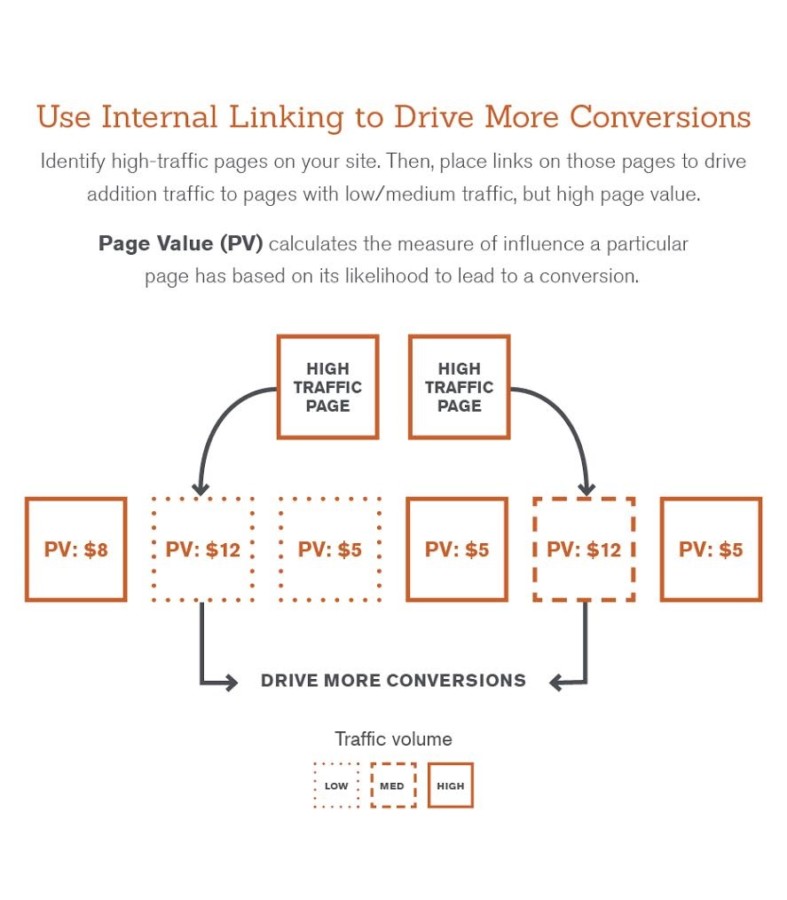 It’s important to point out that with increased traffic the corresponding page values will likely drop. Don’t fret, this is okay! Later we will discuss advanced segments, and how to develop KPI’s around increasing conversion, rather than focusing on increases or decreases in page value.
It’s important to point out that with increased traffic the corresponding page values will likely drop. Don’t fret, this is okay! Later we will discuss advanced segments, and how to develop KPI’s around increasing conversion, rather than focusing on increases or decreases in page value.
Step 2 - Finding The Right Pages
Page value is a statistical formula, and like most statistics, the accuracy of the information provided increases with an increased sample size. For this reason, you have to view these high page value low-medium traffic pages with a grain of salt depending on their sample size (traffic). Like the Google blog pointed out, “page value is not a silver bullet,” meaning the page value metric is not going to hand you the key to increasing conversions on a silver platter.
Nevertheless, you cannot ignore these pages because of their small sample size. This strategy is all about seeing what happens when you drive more traffic to the page. One method I use is increasing the date range on the data. This will increase the sample size, and if the page has consistently earned a high page value over a long period of time, it’s a safe bet that it will continue to do so when you drive more traffic to this page with internal links.
Step 3 - Proper Targeting
So... you find a few pages with high page values and low-medium traffic and slap the link on a few high traffic pages. Job well done, right? Not quite.
For this strategy to work, you have to build an internal linking strategy with an audience first mind set. The example I like to use is the following:
If your high traffic pages are product descriptions for your software and your high page value web page is selling an alternate consulting service offered by your corporation, it doesn’t matter how well the page converted historically, it’s not gonna anymore!
For this reason, understanding your audience is pivotal in building a successful internal linking campaign using the page value metric.
Additionally, it is important to properly target using the conversion funnel. For internal linking, you can plan to drive users down the funnel (i.e. interest page to desire page), or horizontally within the funnel (i.e. interest page to another interest page).
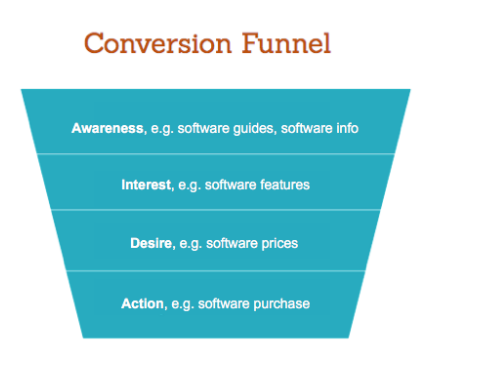
Imagine your enterprise-level software company posted a blog article about the new features of an upcoming release, targeting users at the interest level of the conversion funnel. You might try to move this user from the interest to the desire phase by internally linking to a post with the prices and release dates of the new software. In addition, you might internally link to an article with additional news about the product, keeping the user at the interest level of the funnel and providing more helpful resources.
Step 4 - Using Advanced Segments to Track KPIs
It’s important to realize that the goal of this strategy is to increase overall conversions, rather than increasing individual page value. Using advanced segments, you can track how much a target page has contributed to an individual goal, or total goals, set in GA. Therefore, you can set campaign KPI’s based on conversions, rather than an increase or decrease in page value.
Here’s how this is done:
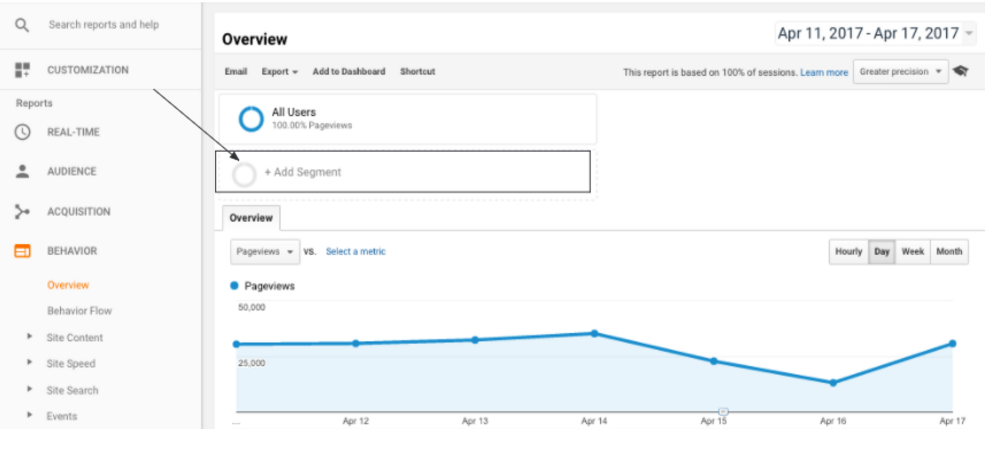
- Click + Add Segment
- Click + New Segment
- Click Conditions on the Advanced Options
- Set the options to the parameters in the following image:

- Add a Segment Name and click Save
- Go to Conversions -> Goals -> Overview
In the “Goals Overview” you will be able to see how much the target page (new segment) has contributed to each goal for a specified time period. This is because the advanced segment ‘sessions’ is telling GA to include data where the specified page was seen at any point in a user's session (i.e. you can see how much target web pages contribute to each goal).
Here’s why this matters, Imagine you work for a digital agency and you come up with an internal linking campaign based around the page value metric for a client. You inform your client that the page value is likely going to drop with increased traffic, and that’s a tough sell. What you have to do is build your campaign KPI’s around conversions, rather than focusing on an increase or decrease in the individual page values. This advanced segment technique is the easiest way to track an individual web pages’ contribution to goals before and after the proposed campaigns.
For more information on building segments visit build new segments.
Helpful Tip: Use GA Advanced Filters to Decrease Noise
You might be telling yourself, well this all sounds fine and dandy, but I have thousands of pages within my website. How in the world am I going to find these high-page value, low-traffic pages? Use Google Analytics advanced filters to decrease the noise (and minimize unnecessary data) within your GA account.
Imagine your software company has 10,000+ pages on your website. Using this method, you are looking for 10-15 pages within those thousands, that are being underutilized and therefore are perfect for an internal linking strategy. To find these pages, you could use advanced filters similar to the following example.
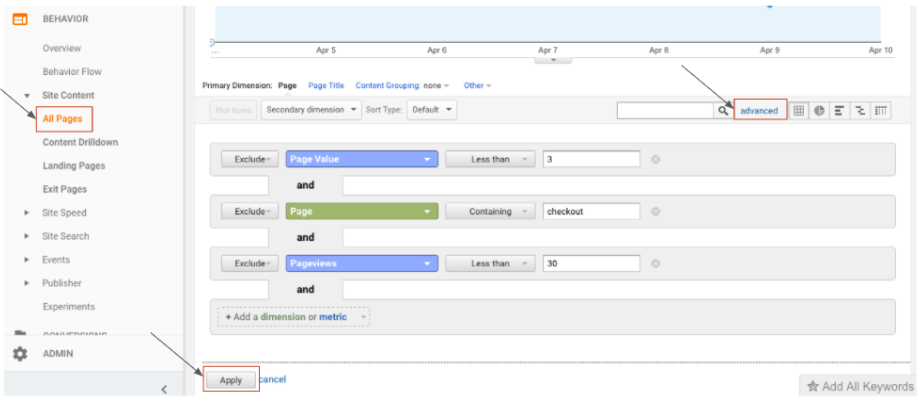
In this example, I excluded pages with a page value less than 3, pages containing the keyword “checkout,” and pages that had less than 30 pageviews. I excluded this content because it’s either irrelevant to our criteria or didn’t qualify as a page with high page values and low-medium traffic. You’ll find that there are several irrelevant pages with less than 30 pageviews, which is why I normally exclude this data.
Using advanced filters, you can cut down thousands of pages to a select few, excluding pages that don’t fit within your qualifying criteria. This method will be different for most sites, so don’t be afraid to play around with the advanced filters and see what works best for you!
Key Takeaways
- This method lets us quantify our internal linking efforts.
- Proper page value hinges on your ability to set proper goal values. If you improperly value a goal (conversion) it will negatively effect using this method. For more information on setting goal values visit tips to set goal values.
- Audience first methodology - Understanding your audience is key to targeting properly. You have to understand if the user should be sent horizontally or down the conversion funnel, and you cannot link “apples to oranges”.
- Plain and simple, this methodology is all about using data-driven insights to increase conversions from underutilized web pages. Don’t over complicate it.
Have you used page value to guide your internal linking strategy? Leave your thoughts in the comments below!
*This post was written by Jason Melman, a digital marketing intern on the Seer team.


